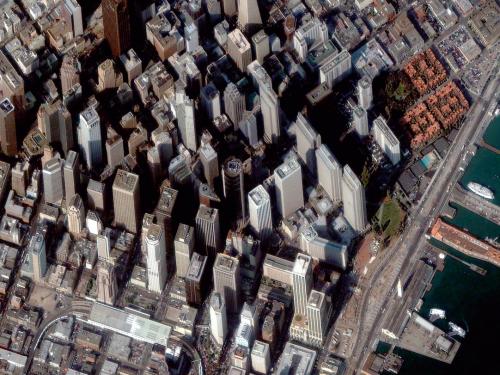
Stories of daring, stories of technological feats, stories of prevailing against the odds ... these are the stories we tell at the National Air and Space Museum. Dive in to the stories below to discover, learn, and be inspired.
Showing 31 - 39 of 39

November 17, 2016
This week is National Geography Awareness Week, an opportunity to reflect on the significance of place and how we affect it. One fantastic way to explore geography is from above. When viewing the Earth from a high altitude or even from space, we can begin to see and record natural and man-made features and events. We can see the remains of civilizations and the aftermath of disasters.

November 01, 2016
Visitors to the newly renovated Boeing Milestones of Flight Hall may miss one particular satellite hanging amongst historical heavyweights such as the Ryan NYP Spirit of St. Louis and the Lunar Module LM-2. This object, however, with its distinctive blue solar panels deployed, is a full-scale engineering prototype of Mariner 2, the first spacecraft to radio useful scientific data from the vicinity of another planet, Venus.

October 17, 2014
Out Of Many, One by Jorge Rodriguez-Gerada is a large-scale portrait, made of sand and soil, temporarily displayed on the National Mall for the month of October.

May 16, 2013
Given the enormous popularity of GPS among civilian users, and the critical applications for the military, it is not surprising that a large body of literature has arisen about the origins of this remarkable technology. The curators of the new Time and Navigation exhibition discuss this history, and we have illustrated it with a few select artifacts, such as the engineering model of the Navy’s NTS-2 satellite, one of the key demonstrators of the technology that led to the deployment of the GPS constellation.

December 28, 2012
Preparation of the upcoming Time and Navigation exhibition is in full swing, and objects are being installed in cases throughout the gallery. In fact, the gallery became a little more shiny just in time for the holiday season thanks to a delivery from our friends at the Naval Research Laboratory.

July 23, 2012
Last week, the Museum recognized the 50th anniversary of Telstar, the first “active” satellite (one that can receive a radio signal from a ground station and then immediately re-transmit it to another) and the first technology of any kind that enabled transatlantic television transmissions. In 1962, both accomplishments generated intense interest, excitement, and commentary.

September 27, 2011
On July 10th, 1962 at 11:47 GMT, the world’s first transmission of a television image by satellite took place, using the Telstar satellite.

April 08, 2011
Most people know that satellites in orbit do useful things such as collect images of the Earth's surface. At the National Air and Space Museum I use satellite images in my job to understand changes in the Earth's land surface.

October 05, 2010
“Remote sensing” is a term used to describe many different types of observations carried out at a distance. Aerial photos, satellite images of the Earth and planets, and telescope views of our solar system are all forms of remote sensing used to understand geology, climate, hazards, and changes over time.